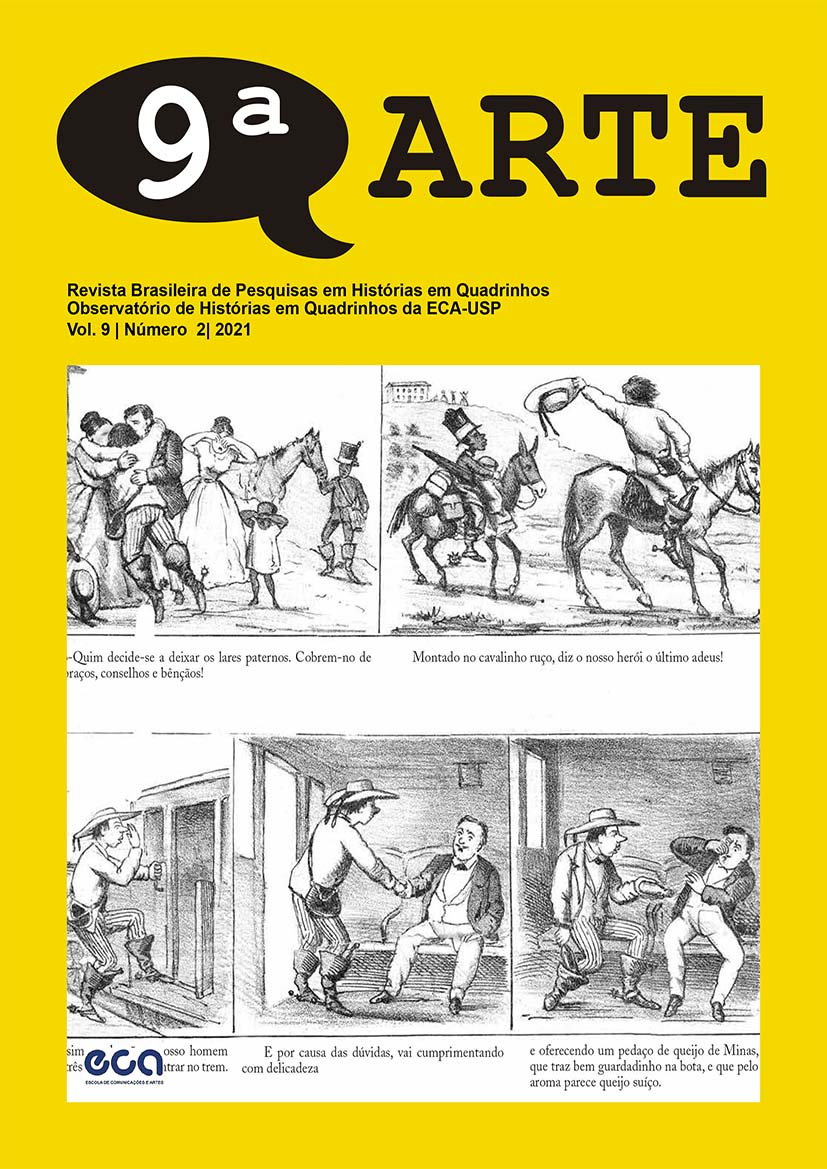Study of paraphrases in comic-books based on Noite na taverna, by Álvares de Azevedo
DOI:
https://doi.org/10.11606/2316-9877.2021.v9i2.185999Keywords:
Comics, Noite na taverna, ParaphraseAbstract
This work aims to analyze how the book Noite na Taverna, of Álvares de Azevedo (2005), was paraphrased in the adaptations to comics of Seriacopi (2011) and Patati (2013), taking into consideration as theoretical perspectives of Fuchs (1985) and Fuchs (1982) apud Duarte (2003). A methodology used in quantitative-qualitative research. In the quantitative research we performed, after a selection of the paragraphs of the original work, a collection and analysis of the data through statistical procedures, using graphs that presented as paragraphs and as ipsis litteris reproductions. About the qualitative research, it performs an analysis of the parables of the categories of Fuchs (1985): logical perspective of the equivalence, grammatical perspective of the synonymy and rhetorical perspective of the reformulation; and Fuchs (1982) apud Duarte (2003): locutive plane, referential plane, pragmatic plane and symbolic plane. The results show that a large part of the adaptation uses the ipsis litteris reproduction from the original text. As for the paraphrases, there is a predominance of the logical perspective of equivalence, followed by the rhetorical perspective of the reformulation and, with less recurrence, the grammatical perspective of synonymy. Regarding the plans, there is a predominance of the locative plan and almost no use of paraphrase in the symbolic plane, certainly to preserve the ideas of the original.Downloads
References
AUSTIN, John Langshaw. Quando dizer é fazer: palavras e ação. Porto Alegre: Artes Médicas, 1990.
ÁLVARES DE AZEVEDO, Manuel Antônio. Noite na Taverna. Belo Horizonte: CEDIC – Centro Difusor de Cultura, 2005.
CANÇADO, Márcia. Manual de semântica: noções básicas e exercícios. Belo Horizonte: Editora UFMG, 2008.
DUARTE, Paulo Mosânio Teixeira. Elementos para o estudo da paráfrase. Revista Letras, Curitiba, n. 59, p. 241-259, jan/jun. 2003.
FUCHS, Catherine. La paraphrase. Paris: Presses Universitaires de France, 1982.
FUCHS, Catherine. A paráfrase lingüística: equivalência, sinonímia ou reformulação? Cadernos de Estudos Linguísticos, n. 8, p. 129-134, 1985.
ILARI, Rodolfo. Introdução à semântica: brincando com a gramática. 8 ed. São Paulo: Contexto, 2014.
ILARI, Rodolfo; GERALDI, João Wanderley. Semântica. São Paulo: Ática, 1990.
MARQUES, Maria Helena Duarte. Iniciação à semântica. 7 ed. Rio de Janeiro: Jorge Zahar Ed., 2011.
OLIVEIRA, Luciano Amaral. Manual de semântica. Petrópolis, RJ: Vozes, 2008.
PATATI, Carlos. Noite na Taverna: história em quadrinhos. São Paulo: Editora DCL, 2013.
PERINI, M. A. Gramática descritiva do português. 4. ed. São Paulo: Ática, 2009.
SANT’ANNA, Affonso Romano de. Paródia, paráfrase & cia. 7. ed. São Paulo: Ática: 2003.
SERIACOPI, Reinaldo. Noite na Taverna. São Paulo: Ática, 2011. (Clássicos Brasileiros em HQ)
Downloads
Published
Issue
Section
License
Copyright (c) 2021 9ª Arte (São Paulo)

This work is licensed under a Creative Commons Attribution 4.0 International License.

Este obra está licenciado com uma Licença Creative Commons Atribuição 4.0 Internacional.



